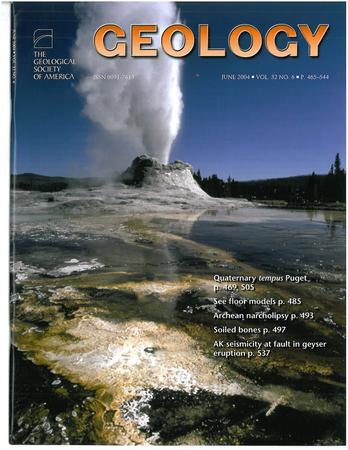Fe isotope decoding of fluid-absent versus fluid-present melting of deeply subducted continental crust
IF 4.6
1区 地球科学
Q1 GEOLOGY
引用次数: 0
Abstract
Fluid-present melting and fluid-absent melting are two primary mechanisms for the chemical differentiation of continental crust. However, it is still challenging to decode these processes with conventional geochemical methods. In this study, we present systematic Fe isotope data of anatectic migmatites and gneisses from the Dabie orogen, China, which were formed by different mechanisms of crustal anatexis. Fluid-present melting of biotite generates migmatites with restricted Fe3+/ΣFe (0.31−0.44) and homogeneous δ56Fe values (0.06‰−0.17‰). In contrast, fluid-absent melting of phengite produces migmatites and migmatitic gneisses with dramatic Fe3+/ΣFe (0.26−0.94) and δ56Fe (0.04‰−0.61‰) variations. Quantitative modeling of Fe distribution during partial melting reveals that Fe isotope fractionation is governed by source mineral assemblages under varying melting regimes. During fluid-absent melting, the reactant phengite has much higher Fe3+/ΣFe and δ56Fe values than the peritectic biotite, resulting in high and heterogeneous δ56Fe values in the complementary melt. In contrast, during fluid-present melting, the reactant biotite and peritectic amphibole have similarly low Fe3+/ΣFe and δ56Fe values, leading to low and homogeneous δ56Fe values in the complementary melt. This establishes Fe isotopes as a novel tracer for crustal anatexis, critical for understanding continental reworking and intracrustal differentiation.深俯冲大陆地壳无流体与有流体熔融的铁同位素解码
有流体熔融和无流体熔融是大陆地壳化学分异的两种主要机制。然而,用传统的地球化学方法解码这些过程仍然具有挑战性。本文对中国大别造山带由不同的地壳深熔作用机制形成的深熔混合岩和片麻岩进行了系统的铁同位素研究。黑云母流体熔融生成混杂岩,Fe3+/ΣFe(0.31 ~ 0.44)受限制,δ56Fe值(0.06‰~ 0.17‰)均匀。而无流体熔融的辉长岩则形成混杂岩和混杂岩片麻岩,其Fe3+/ΣFe(0.26 ~ 0.94)和δ56Fe(0.04‰~ 0.61‰)变化剧烈。部分熔融过程中铁同位素分布的定量模拟表明,不同熔融条件下的源矿物组合控制着铁同位素分异。在无流体熔融过程中,反应物云母的Fe3+/ΣFe和δ56Fe值远高于包晶黑云母,导致互补熔体的δ56Fe值高且不均匀。相比之下,在流体熔融过程中,反应物黑云母和包晶角闪孔的Fe3+/ΣFe和δ56Fe值同样较低,导致互补熔体的δ56Fe值较低且均匀。这表明铁同位素是一种新的地壳熔合示踪剂,对理解大陆改造和地壳内分化至关重要。
本文章由计算机程序翻译,如有差异,请以英文原文为准。
求助全文
约1分钟内获得全文
求助全文
来源期刊

Geology
地学-地质学
CiteScore
10.00
自引率
3.40%
发文量
228
审稿时长
6.2 months
期刊介绍:
Published since 1973, Geology features rapid publication of about 23 refereed short (four-page) papers each month. Articles cover all earth-science disciplines and include new investigations and provocative topics. Professional geologists and university-level students in the earth sciences use this widely read journal to keep up with scientific research trends. The online forum section facilitates author-reader dialog. Includes color and occasional large-format illustrations on oversized loose inserts.
 求助内容:
求助内容: 应助结果提醒方式:
应助结果提醒方式:


